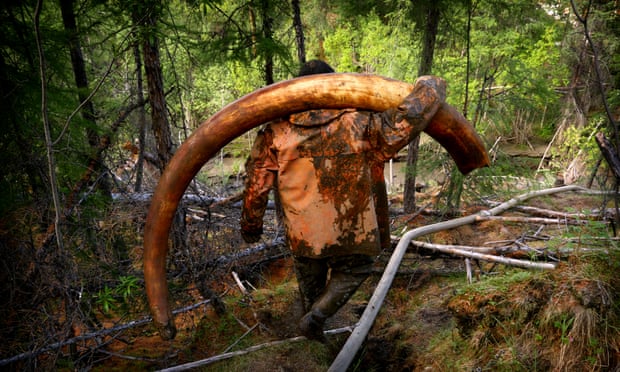Prospectors in Russia dig up remains of extinct animals for trade worth an estimated £40m a year
Activists and officials in northern Russia have warned of a “gold rush” for mammoth ivory as prospectors dig up tusks and other woolly mammoth remains that can net a small fortune on the rapacious Chinese market.
Melting permafrost from global heating has made it easier for locals to retrieve the remains of woolly mammoths, which have been extinct for thousands of years, and sell them on to China, where the ivory is fashioned into jewellery, trinkets, knives, and other decorations.
Woolly mammoth ivory preserved in the permafrost in Russia’s Yakutia region make up 80% of Russia’s trade in a largely unregulated market worth as much as £40m each year, according to Russian officials.
“The process of harvesting mammoth remains needs to be regulated,” said Vladimir Prokopyev, a regional official in Yakutia who has warned about the dangers that the business poses for locals. Local officials have warned that large business interests or an outright ban on harvesting mammoth remains could disenfranchise locals, who should have the right to collect a limited amount of tusks and live off the proceeds.

Prospectors can spend the bright summer months in a hunt for tusks using simple digging tools or water pumps to excavate prizes that can lead to fantastic riches, but also cause environmental harm. Amid growing competition for the tusks, local firms are now reportedly using divers to search riverbeds in remote areas that can be reached only by motorboat.
Yakutia, formally called the Sakha Republic, has proposed legislation to regulate the trade in mammoth ivory and federal authorities say they are discussing formal language. But in the meantime, production has grown as high as 100 tonnes each year, and Chinese traders have begun buying direct from local prospectors.
Mammoth ivory has been promoted in China as an ethical alternative to tusks poached from African elephants. Prokopyev has estimated that Yakutia’s unearthed reserves of mammoth fossils amount to 500,000 tonnes. Russian media have reported that while 70 tonnes were unearthed in 2017, more than 100 tonnes were excavated in 2018.

Tens or hundreds of thousands of woolly mammoths that used to roam the northern region of Russia are believed to be buried there now. They largely disappeared from Russia around 10,000 years ago because of factors such as hunting and climate change.
In a first, an international organisation will review a proposal to give protected status to woolly mammoths under a convention dedicated to endangered species, despite the fact that it has been extinct for thousands of years. The proposal will be discussed at a global conference of the Convention on International Trade in Endangered Species of Wild Fauna and Flora (CITES).
Several films released in the last year have called for new legislation on the trade of mammoth ivory. One documentary on state television harshly criticised prospectors, prompting local collectors to tell AFP that they were worried they had been portrayed as “millionaire poachers”.
Another film called Passions for the Mammoth charted rising demand and social tensions over mammoth ivory in Yakutia. The film has received a warm response from Russian officials.
During a showing of the film in Russia’s state Duma, the film-maker argued that “the mammoth can save the elephant”, adding that Russia’s ivory reserves could allow Russia to be a “monopolist in delivering this material to world markets”.

